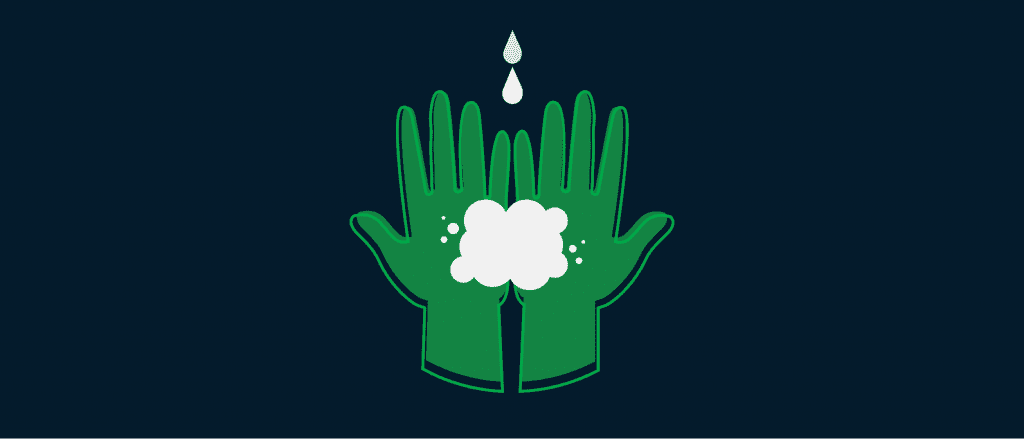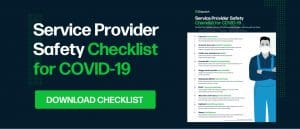As of March 30, there have been more than 140,000 confirmed cases of COVID-19 in the U.S. schools and businesses have closed, travel plans are on hold, and many of us have been ordered to shelter in place. But field service providers still have to do their jobs. So the question is, what are the best Covid-19 practice guidance for service providers and how do you keep them safe in and around customers’ homes?
How to Keep Your Service Providers—and Customers—Safe from Coronavirus
While there’s no zero-risk way to perform essential work inside customers’ homes, you can take these steps and best Covid-19 practice guidance for service providers to reduce the chance of spreading COVID-19:
- Update your on-site safety guidelines. Base your new rules on CDC guidelines for reducing the risk of spreading the virus.
- Keep your distance. Experts suggest maintaining six feet of distance between yourself and other people.
- Assess everyone’s health before going out. Ask your service providers and customers if they’re feeling ill—and reschedule appointments if the answer is yes.
- Adopt contactless communication. With photos, messaging, and digital payments, you can minimize exposure between service providers and customers.
Read on for more details on each step.

Update Your On-Site Safety Guidelines
Your service providers may be understandably nervous about coming into contact with customers and the equipment in their homes. Giving them tips on Covid-19 practice guidance for service providers for reducing their risk of contracting or spreading the coronavirus will make them and your customers feel more at ease.
Here are a few essential practices for service providers, based on CDC guidelines:
- Wash your hands before, during, and after each work order. This video demonstrates, how to ensure you’re scrubbing every part of your hands.
- Use hand sanitizer with at least 60% alcohol content if you don’t have access to soap and water.
- Don’t touch your face (especially your eyes, nose, and mouth). Studies have found that we touch our faces between 16 and 23 times per hour—a habit that can be seriously hard to break. Adding a new ring or a rubber band around your wrist can help make you conscious of your hand, and remind you not to touch your face with it.
- Disinfect tools and surfaces of any appliance or equipment you’re working with on the job and between work orders. As much as possible, avoid touching any other surfaces in the home; the coronavirus can live on some surfaces for several hours.
- Add this COVID-19 safety checklist to every work order, so your service professionals don’t have to try to remember the new procedures during busy workdays.
Keep Your Distance
Because COVID-19 spreads through person-to-person contact, maintaining a distance of six feet from other people can reduce the chance of transmission. This might present a challenge in some homes, so prepare your service providers and customers ahead of the visit.
Have an email newsletter, customer text app, or blog? Use whatever communications tools you have to let customers know your service professional won’t be shaking hands and that they’ll ask the customer to stay six feet away at all times. Reassure customers that your service professional is disinfecting tools and equipment between visits, and ask that they provide access to a sink and soap.
Finally, take care of as much of the transaction as possible outside the customer’s home. That includes the initial conversations about the work and any paperwork required (more on that shortly).
Assess everyone’s health before rolling trucks
While COVID-19 can be asymptomatic, there are some signs you can look for to reduce the chance of spreading it.
Ask your service providers to notify you if they have any cold or flu symptoms, especially a cough, fatigue, or fever. Any service provider showing these symptoms should stay home, along with any service provider who’s been in contact with a person who tests positive.
Before sending a service professional to your customer’s home, ask if anyone in the house is sick. And make it clear to your service team that they can and should ask the same question once they arrive. If anyone in the home is sick, service providers should check with supervisors to assess whether the work can be rescheduled.
Innovate with Contactless Communication
Your goal should be to limit coronavirus exposure between your field service providers and customers. Leveraging tools with robust messaging capabilities can help you accomplish that task.
A platform that allows text messaging (or even better, video), can help you diagnose the problem before rolling a truck. Connecting virtually before the job ensures technicians arrive with all required parts and tools, meaning fewer exposures between the shop and the customer’s home and less time disinfecting tools
You can also reduce the chances of infection by improving the way your customer signs off on the job once it’s complete. Instead of a signature on paper, send a confirmation email or ask them to confirm via your app or website. Offer digital payment methods so paper checks don’t have to change hands.
We hope these minor adjustments help your process and workflow as we all continue navigating work-related changes because of COVID-19. Additionally. your work is ensuring homes are safe and comfortable and that is something that homeowners will forever be thankful for.
Need a little tech help with implementing contactless communication? Schedule a demo to see how the right platform can reduce physical contact and keep everyone safer.




